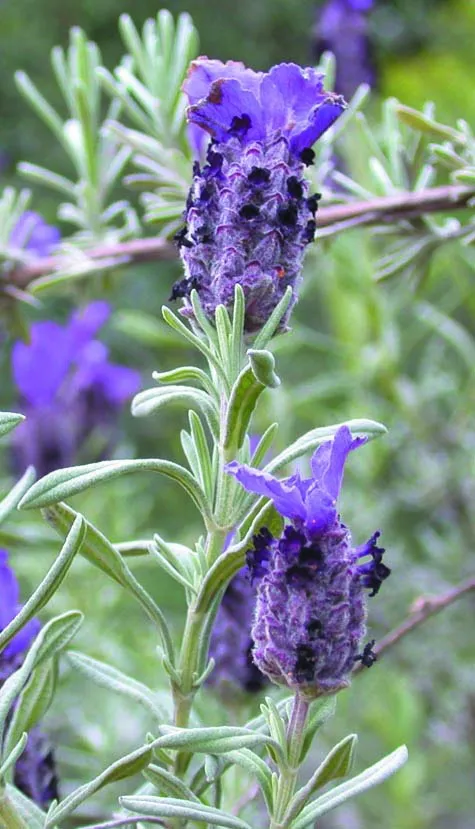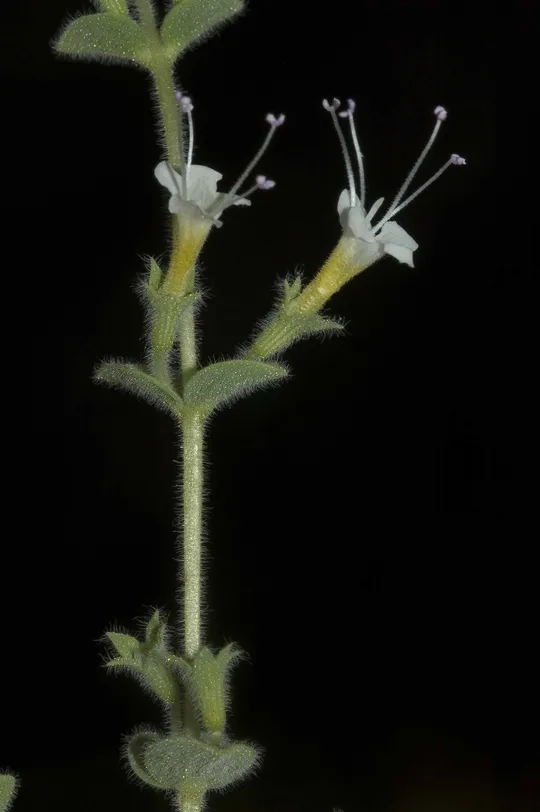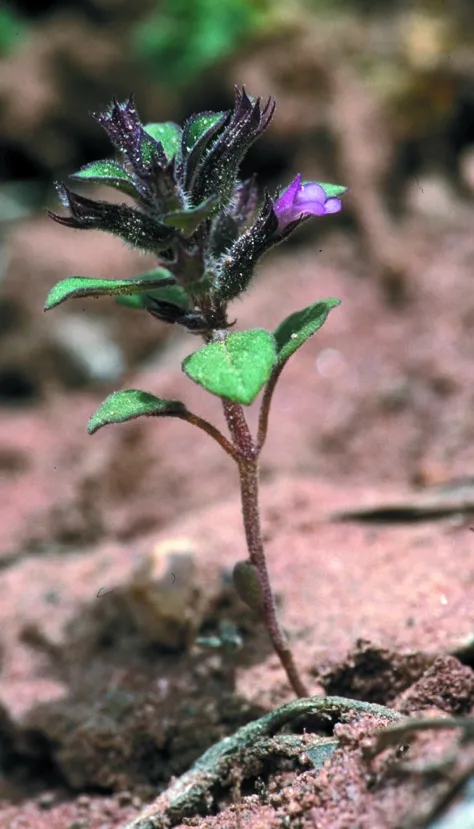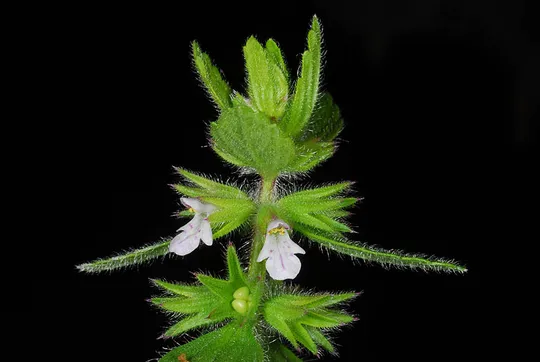Slender Ziziphora, Spear-leaved Ziziphora
Ziziphora tenuior
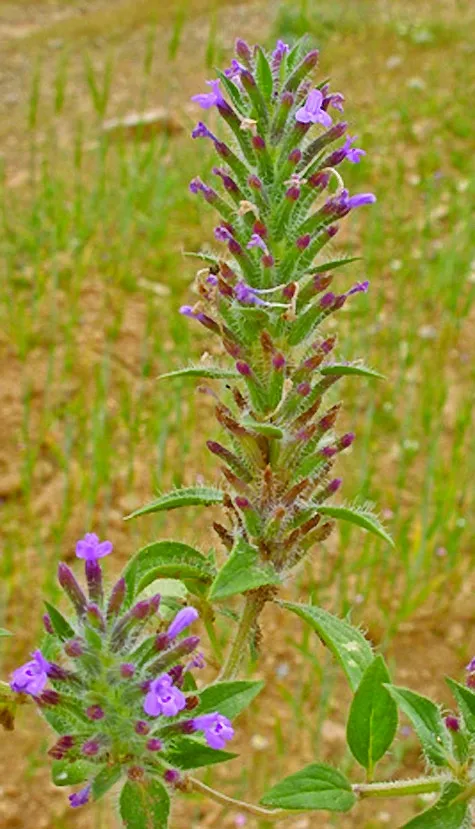
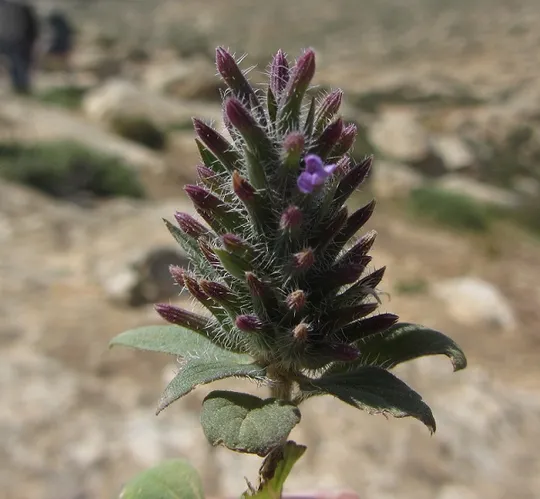
Ziziphora tenuior is a small, erect highly aromatic annual
herb 5-10 cm tall, with narrow lanced leaves. It blooms from late
March to early April. Its minute pink flowers
are arranged in a dense, elongated spike-like inflorescence. The
calyx is tube-like, long and narrow, slightly two lipped at the upper
opening, with five minute teeth and 13 protruding ribs. The
corolla forms a narrow tube, 6-7 mm long that protrudes from the inflorescence
bracts. The top of the corolla tube ends in four similar lobes; the lower lip
is divided into three slightly rounded lobes and the upper
lip (the fourth lobe) is narrow, upright and
entire. Two of the four stamens (the lower pair) have atrophied into
small organs, and the remaining two protrude from the corolla tube
and are located beneath the flower’s upper
lip. Only one cell in each anther is fertile. The
fruit is composed of four smooth nutlets, which remain encased in the dry
calyx. Seed (nutlet) production is high (80%), which suggests that most
of the seeds result from self-pollination. The species has no unique
dispersal method; the rough calyx and flower attach to socks and sheep’s
wool for short periods of time.
In Edom (south west of the Dead Sea) and Southern Sinai the Bedouins use it as a spice and an aromatic herb. Women keep dry blossoms in cloth bags, and use them to scent their clothes and tents. The dry leaves may be used for tea.
Has been found only three times in the country. In the Judean Hills it grows in the Mediterranean-desert ecotone belt near Bani Na’im east of Hebron (1942) and in Ma’ale Hever (Oz Golan 2003). Recently Oz Golan found a large population of Ziziphora tenuior near the Zif Ruins, southeast of Hebron, at an altitude of 900 meters. These plants have broad base leaves, similar to Z. capitata, but their inflorescence is elongated with narrow leaves, which is typical of Ziziphora tenuior. In the Samarian desert the species grows in Wadi al Malih (1975) and in the Negev Highlands it is found at the Louts Cisterns (1983). Flora Palaestina has data from the lower Jordan Valley, the Judean Desert, Mt. Hermon, and the Aravah, but the validity of these data is questionable.
Rocky limestone slopes in the Mediterranean-Desert ecotone and high Desert Mountains. The natural habitat of this species is very common and it is therefore not clear why it is so rare. Possibly the extent of its natural habitats should be reduced and limited to “high ecotone regions”; where snow falls in the winter and temperatures are lower than in the other ecotones.
Can be distinguished from Ziziphora capitata by its elongated, erect inflorescence and its lanceolate leaves. They have a particularly pleasant odor (similar to that of Ziziphora clinopodioides from Mt. Hermon), unlike Ziziphora capitata whose leaves have no smell and whose flowers are arranged in whorls on a spherical head. There are no transitions between the two species, despite the similarity of their habitats and their morphological similarity (possibly due to self-pollination in both species).
• Accelerated development severely damages its natural habitats in the Bani Na’im area and throughout the Mediterranean-desert ecotone in Judea and Samaria. The area of Wadi al Malih is currently subject to overgrazing and is a formally closed as a military training area, so that it is under no supervision or control. The only site in which the plant is protected in a nature reserve is the Lots Cisterns Nature Reserve in the Negev Highlands, but this is a much more marginal habitat than the other two.
• The three sites in which the species is found in Israel are remote and very isolated from each other. All efforts made to find the plant (small but very attractive because of its uniqueness and uses) in the areas in-between the three sites were unsuccessful. Similarly, attempts to return to the Bani Na’im area and find the species were unsuccessful.
• The three populations in Israel are very small. It could be possible to regard them as a marginal population of the main distribution area in the eastern Jordanian plateaus, where the species is found in large patches. We have no solid information on their population sizes and dynamics. It is possible that there are numerous seeds in the ground in Mediterranean-desert ecotones and in the Negev Highlands that germinate and flower only rarely (possibly in rainy years).
• The species is extremely rare in Israel, but quite common in the high Middle East ecotones, and not globally threatened.
• It is protected in only one of its three populations, in the Negev Highlands Reserve.
We recommend locating plant populations are in the Wadi al Malih and Lots Cisterns area, conducting long-term monitoring that includes an examination of the seed bank.
An Irano-Turanian plant from the high steppes of Central Asia and the Middle East mountains. Ziziphora tenuior is relatively common in Edom above 1200 m and on the peaks of the Southern Sinai Mountains. It does not grow to the west and south of Southern Sinai or in Cyprus.
A minute annual plant, used for tea and as a fragrance. Common on the high steppes of southern Jordan and Sinai, very rare to episodic in Israel. In Israel it is characteristic of the high ecotones and the Negev Highlands. A vulnerable red plant, due to the minuscule number of existing sites and individuals observed in Israel. It has become extinct in one of the three where it was previously observed, and only one of the sites is located in a nature reserve. A population in the Amon Ridge should be restored and monitored.
Current Occupancy Map
| 1000 squre meter pixel | 5000 squre meter pixel | 10000 squre meter pixel | |
|---|---|---|---|
| number of observations | 0 | 0 | 0 |
| in total pixels | 0 | 0 | 0 |
| Family | Lamiaceae |
| Classification | On the endangered species list |
| Ecosystem | High Semi-Steppe |
| Chorotype | Irano-Turanian |
| Conservation Site | Mitzpe Yair Area Ma'on ridge |
| Rarity |
1
6
6
|
|---|---|
| Vulnerability |
0
0
4
|
| Attractiveness |
0
4
4
|
| Endemism |
0
0
4
|
| Red number |
1
6.0
10
|
| Peripherality | 0 |
| IUCN category | DD EW EX LC CR EN VU NT |
| Threat Definition according to the red book | Critically endangered |
 Based on:
Based on:
